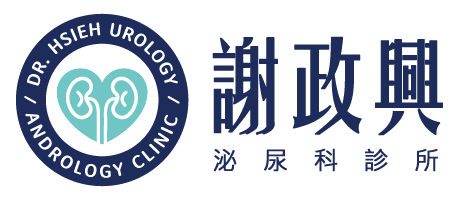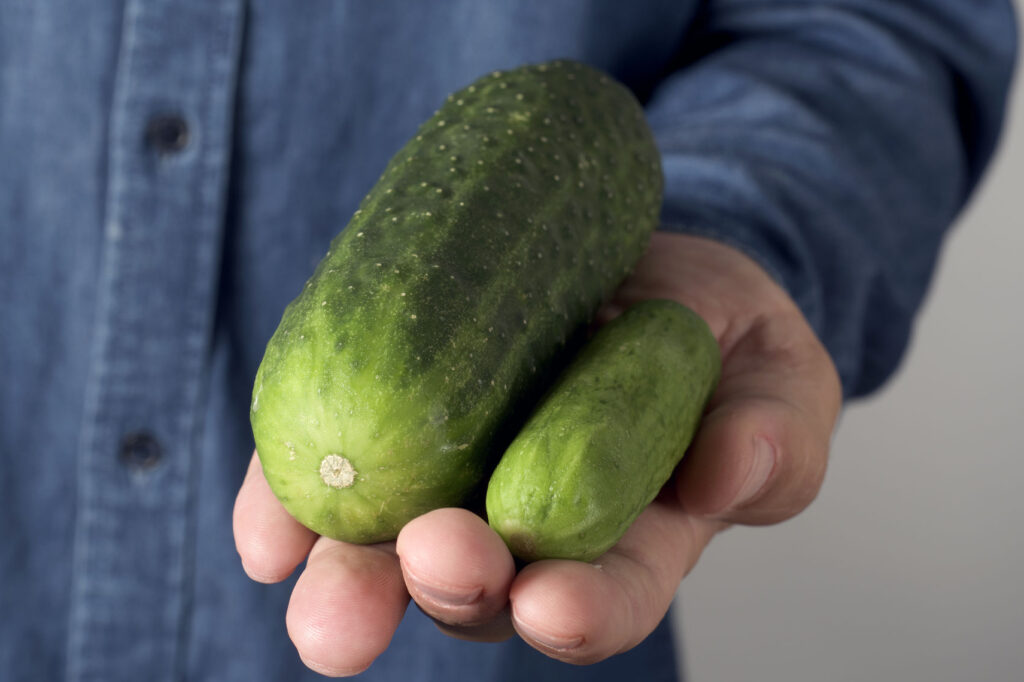陰莖靜脈截除手術基本原理(Rationale)
以前認為勃起功能障礙的原因大部分是精神性因素(psychogenic factor),後來發現大部分勃起功能障礙的原因是器質性因素(organic factor) [Davis et al, 1985]。器質性因素包括血管性因素(vasculogenic factor)、神經性因素(neurogenic factor)、荷爾蒙性因素(hormonal factor)、海綿體平滑肌異常或病變(cavernosal smooth muscle abnormalities or lesions)[ Melman and Gingell, 1999]。
器質性因素中,血管性因素(vasculogenic factor),特別是靜脈因素(venogenic factor),扮演最主要的角色[Wagner, 1981; Lue et al, 1983; Lue et al, 1984]。根據統計,陰莖靜脈滲漏的發生比率約佔血管性因素的80%(68-92.5%)[ Rajfer et al, 1988; Fuchs et al, 1989]。
容易發生陰莖靜脈滲漏的因素(predisposing factor)包括高血脂、高血壓、糖尿病、海綿體慢性缺氧(chronic ischemia)、陰莖動脈灌流不足(arterial insufficiency)、陰莖彎曲(penile curvature)、陰莖外傷、佩諾尼氏症(Peyronie’s disease)、海綿體神經(cavernous nerve)損傷等[Nehra et al, 1996; Kendirci et al, 2007]。
當血液經由陰莖動脈流入陰莖海綿體,陰莖海綿體內充血後,如無法有效壓迫住陰莖靜脈系統,血液將很快流出陰莖海綿體,導致勃起功能障礙;當然,陰莖靜脈滲漏程度不一樣,勃起硬度就會有差別[Lewis, 1988; Hsu et al, 1993; Nehra et al, 1996; Moreland, 2000; Dean and Lue, 2005]。
陰莖靜脈系統在勃起功能中扮演十分重要的角色,但醫學文獻往往只是大概描述[Fuchs et al, 1989; Moscovici et al, 1999],即使當今解剖或泌尿科學教科書上所描述的陰莖靜脈系統亦不十分精確[Lue, 2007](圖1)。
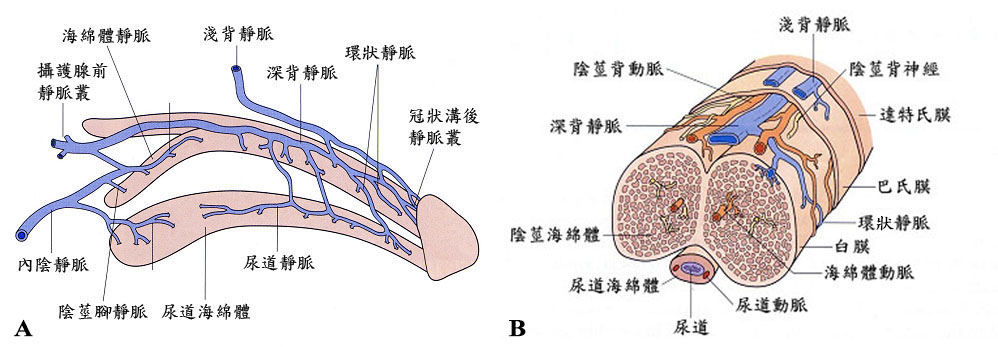
圖1. 傳統醫學文獻及教科書對於陰莖靜脈系統解剖構造的解說並不完全精確,主要描述淺背靜脈、深背靜脈、環狀靜脈、陰莖腳靜脈及短促的海綿體靜脈。
1999年許耕榕教授等發現若干醫學文獻及解剖教科書上從未描述過的靜脈,經由反覆的解剖及臨床攝影檢查,掃描式與穿透式電子顯微鏡的輔助,證實陰莖靜脈眾多且複雜,除了以往所描述的深背靜脈(deep dorsal vein)系統外,還有之後命名的海綿體靜脈(cavernosal vein)及動脈旁靜脈(para-arterial vein)兩組系統。深背靜脈位於陰莖背側正中間;在深背靜脈左右兩側較深處(貼近白膜)各有一條海綿體靜脈,事實上,海綿體靜脈很長,幾乎有整個陰莖海綿體的長度,並非傳統所描述僅是位於陰莖腳(penile crura)短短的一小段靜脈;在深背靜脈兩側各有一條背動脈,每條背動脈則又各被兩條動脈旁靜脈所包夾(一條是內側動脈旁靜脈,另一條是外側動脈旁靜脈)(圖2) [Hsu et al, 2002; Hsu et al, 2003a]。以上這些靜脈係匯聚龜頭、陰莖海綿體的血液,回到體內循環系統。
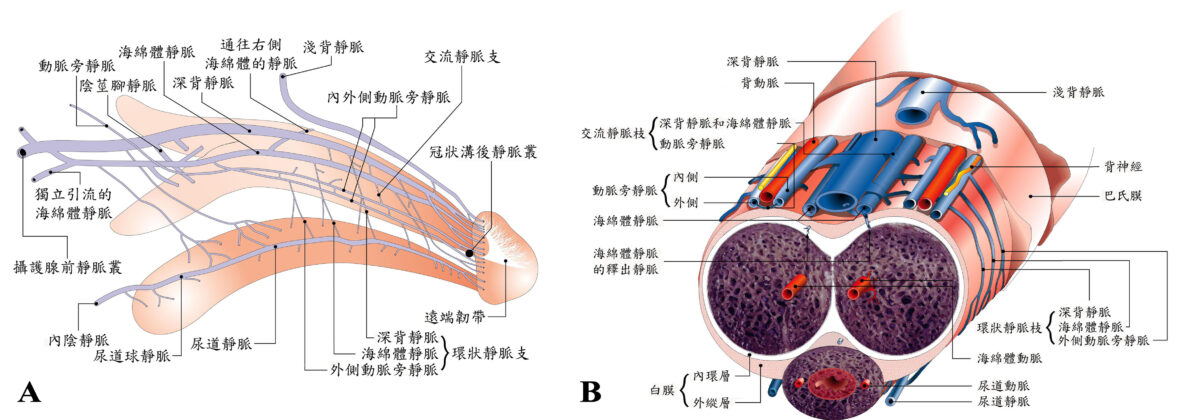
圖2. 最新發現的詳細陰莖靜脈系統解剖構造圖A.右側視圖,B.橫切面圖。陰莖靜脈系統包括淺背靜脈、深背靜脈位於陰莖背側正中間,在深背靜脈左右兩側較深處各有一條海綿體靜脈,海綿體靜脈很長,幾乎延伸達整個陰莖海綿體的長度。深背靜脈兩側各有一條背動脈,每條背動脈又各被兩條動脈旁靜脈所包夾。另有環背靜脈及陰莖腳靜脈。
陰莖靜脈滲漏造成的勃起功能障礙,就需手術將滲漏的陰莖靜脈截除或綁紮,以減少靜脈血液回流,讓血液不會很快流出陰莖海綿體,使陰莖海綿體內維持充血狀態,達到足夠從事性行為的勃起硬度。但傳統的陰莖靜脈截除手術只是截除一部分陰莖深背靜脈,卻未一網打盡其餘的靜脈系統;這些未被完全截除的殘餘靜脈(residual vein),以前常被誤認為是再生的靜脈(recurrentvein),將慢慢鼓脹成為陰莖靜脈滲漏的來源,逐漸影響病人的勃起功能[Chen et al, 2005; Hsu et al, 2006]。這情形可以解釋為何盛行於1990年代的陰莖靜脈手術,終因術後效果不佳而被棄之如敝屣[Puech-Leaoetal,1987; Lue,1989;Montagueetal,1996];而只有建議條件非常好(highly selective)的病患(輕微陰莖靜脈滲漏,無精神性因素或其他器質性因素,服藥效果不佳、只剩下海綿體內藥物注射、真空吸引器或植入人工陰莖治療方式可以選擇的年輕人)才適合接受這種手術[Freedman et al, 1993; Berardinucci et al, 1996; Da Ros et al, 2000]。因此,完全了解陰莖靜脈系統的分佈,據此做為陰莖靜脈截除手術的藍本,才能完美處理滲漏的陰莖靜脈。
手術適應症(Indication)
受勃起功能障礙困擾半年以上、診斷有陰莖靜脈滲漏、經性功能門診咨商、充分告知、篩選的病患,排除精神性因素、男性荷爾蒙缺乏症(Androgen deficiency)或高泌乳症(hyperprolactinemia)、神經系統疾病(Neurological disease)、嚴重陰莖動脈灌流不足、嚴重或控制不良的慢性全身性疾病(例如糖尿病、肝硬化及尿毒症) 、服用可能導致勃起功能障礙藥物、出血性體質,原則上均可考慮採用,不受年齡及陰莖靜脈滲漏程度的限制。這種手術對於其它治療方式[例如口服磷酸二酯脢–第5型(Phosphodiesterase-5,PDE-5)抑制劑、海綿體內藥物注射、真空吸引器等]不適用或失效,但又不想立刻植入人工陰莖的病患,是另一種替代性的選擇。當然,造成勃起功能障礙的相關可逆因素,包括缺乏運動、肥胖、抽煙、代謝症候群(高血脂、高血壓、高血糖)、心因性勃起功能障礙、荷爾蒙性勃起功能障礙、外傷後血管性勃起功能障礙等,也必需同時矯正,才能獲得加乘的效果[Wespesetal,2009]。如果病患同時有較厲害的陰莖彎曲(例如彎曲角度超過30度),手術時最好一併矯正。
麻醉方式(Anesthesia)
傳統的陰莖靜脈手術多半採用半身麻醉或全身麻醉技術,病患術後需住院數日。但如能詳細了解陰莖的顯微結構[Hsu et al, 2004a],更好的麻醉方式應是採用精緻的局部麻醉技術,所使用的局部麻醉藥Xylocaine劑量不超過400毫克(mg),相對安全又方便,陰莖靜脈截除手術變成門診手術,病患術後即可返家[Hsu et al, 2003b; Hsu et al, 2007],較不影響日常生活及工作。
背神經近枝阻斷術(proximal dorsal nerve block) (圖3-1):以左手將陰莖本體往陰莖腳(penile crura)側推開,在陰莖恥部皺摺(infrapubic fold)近側正中0.5-1.0公分(cm)處以針尖斜走90度往深處、懸吊靭帶(suspensory ligament)中間插針,沿恥骨(pubic bone)斜角從骨膜外緣進針。腎上腺素可以延長麻醉藥物作用時間[Bernards and Kopacz, 1999],預先用腎上腺素(epinephrine)潤飾過的無菌鋼杯調配0.8%,50毫升的Xylocaine溶液,經由10毫升(mL)的針筒注射三個方向:正中陰莖門部(penile hilum),双側各側行10度的左右背神經近枝。數分鐘後用齒鑷(toothed forceps)測試局部麻醉效果。
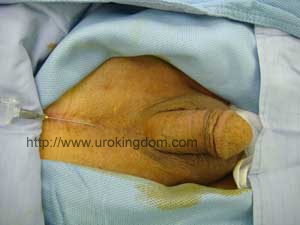
周陰莖基部組織阻斷(peripenile infiltration) (圖3-2):用手指觸感引導,在基部局部注射周陰莖組織,其後仔細注射尿道海綿體與陰莖海綿體交界的二側組織。由於尿道海綿體的白膜較薄弱,應避免刺穿。
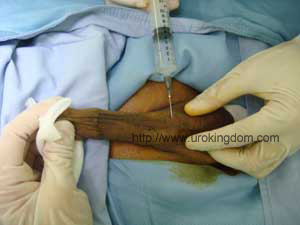
手術方法(Surgical Technique)
傳統的陰莖靜脈手術在陰莖陰曩交界處環狀切開一道切口,傷口大且組織破壞多[Lue, 1989]。我們以最新了解的陰莖靜脈系統做為陰莖靜脈截除手術的藍本[Hsu et al, 2002; Hsu et al, 2003a]。病患採平躺姿勢,按照一般原則剃除毛髮、消毒及鋪無菌單。在恥骨部表皮正中縱切長度約3-4公分的傷口,保留表淺較明顯的靜脈,小心游離傷口內面組織,進入柯立氏膜(Colles’fascia),打開的空間儘量到達陰莖遠端及側邊以游離部份陰莖本體(圖4-1),將陰莖本體外翻(圖4-2)。以擠牛奶的手法擠壓陰莖海綿體,可輕易辨認靜脈,深背靜脈需完全截除並以6-0尼龍線(nylonsuture)貼近白膜綁紮匯流至深背靜脈的小分支靜脈,儘量處理到遠端龜頭後冠狀溝的小靜脈,此處小靜脈數目眾多。截除過程中,以深背靜脈主幹當引導,在巴氏膜(Buck’s fascia)上跳躍式打洞而非完全打開以減少組織傷害,應用類似拔河的手法將整條深背靜脈截除(圖4-3);過程中任何靜脈靠近海綿體的一端,均以6-0尼龍線牢牢紮住,否則猛烈的出血不但嚇人,而且模糊視野無法繼續進行手術。環形靜脈(circumflexvein)的處理亦然,但是動脈旁靜脈僅能一段一段綁紮。接著把翻出的陰莖歸原位,並立即以紗布纏繞。以同法截除海綿體靜脈(圖4-4),清楚辨識尿道海綿體肌並綁紮兩側陰莖腳靜脈(cruralvein)。
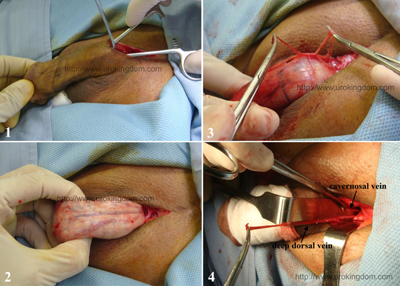
在恥骨部表皮正中縱切長度約3-4公分的傷口,進入柯立氏膜(Colles’ fascia),打開的空間儘量到達陰莖遠端及側邊以游離部份陰莖本體。2)將陰莖本體外翻,以擠牛奶的手法擠壓陰莖海綿體,可輕易辨認陰莖靜脈。3)截除過程中,以深背靜脈主幹當引導,在巴氏膜(Buck’s fascia)上跳躍式打洞而非完全打開以減少組織傷害,應用類似拔河的手法將整條深背靜脈截除。4)翻出的陰莖歸原位,將深背靜脈與海綿體靜脈一併截除。
最後,皮膚傷口可以用6-0尼龍線或5-0羊腸線(chromiccatgut)縫合,陰莖本體重新以紗布纏繞包紮,需鬆緊適度(圖5)。
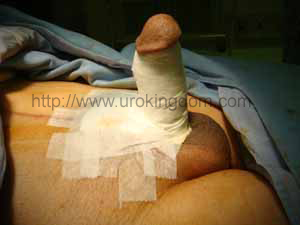
這是一種精緻細膩的手術,手術時間約需3-6小時。特別注意的是,陰莖靜脈截除手術並非截除所有的陰莖靜脈,術者必須保留陰莖淺背靜脈(superficialdorsalvein)及球尿道靜脈(bulbourethralvein),因為前者是淺部陰莖組織生理所需血液回流的管道,而後者負責深部組織的循環;兩者若被截除,將有併發症。手術過程中須綁紮的靜脈端眾多,甚至高達125處,需細心操作,不可用電燒(electrocautery)處理。如果用電燒使陰莖靜脈組織燒焦、凝結,雖可讓海綿體內的血液不會經由陰莖靜脈滲漏,大幅縮短手術時間,但陰莖海綿體也可能因電流傷害而導致海綿體纖維化,造成勃起功能障礙。電燒也可能傷害到緊鄰的陰莖背動脈、神經或包皮組織,產生麻木感或包皮局部缺血壞死或潰瘍等外傷[Sebben, 1987]。另外,許多醫學文獻報告都指出,電燒時局部組織會遭到破壞,這塊燒焦的地方,對細菌的抵抗力下降,傷口較易發炎感染[Bennett and Kraffert, 1990; Soballe et al, 1998; Hsu et al, 2004b]。
可能的併發症(Possible Complications)
局部麻醉的併發症包括針紮到血管(13.8%)、暫時性心悸(3.9%)、皮下淤血(19.3%)等。與手術本身相關的併發症包括血腫、感染、麻木感、包皮局部缺血壞死等,但只要熟練以上手術技巧,發生機率極低。傷口疼痛於術後1-2日較明顯,通常給予Acetaminophen或非類固醇類止痛藥(NSAID)返家服用,即可達到良好止痛效果。
結果與討論(Result and Discussion)
雖然勃起功能障礙有許多原因,其中一個關鍵因素就是陰莖靜脈滲漏。如根據當今解剖教科書上所描述的陰莖靜脈系統做為陰莖靜脈截除手術的藍本,許多未被完全截除的殘餘靜脈,將慢慢鼓脹成為陰莖靜脈滲漏的來源,逐漸影響病患的勃起功能,術後改善程度有限,追蹤效果不佳。根據舊有醫學文獻資料報告,短期追蹤改善比率約50-80%[ Wespes and Schulman, 1985; Bennett et al, 1986; Williams et al, 1988; Stief et al, 1994];長期追蹤改善比率約31-64%[ Freedman et al, 1993; Vale et al, 1995; Berardinucci et al, 1996]。
如根據最新了解的陰莖靜脈系統做為陰莖靜脈截除手術的藍本,在醫學學理上,其術後勃起功能的改善程度應優於傳統的手術方式,這在臨床經驗上已獲得印證,近期的追蹤結果亦顯示此一趨勢,改善比率可達91%[Hsu et al, 2006],但仍需更長期的追蹤結果以獲得相關結論。基本上,熟練以上手術技巧,術後的勃起功能大多會有不同程度的改善,且能避免可能的併發症;但因每位病患體質條件不一,術後效果會因人而異。
對於勃起功能障礙,陰莖靜脈截除手術是最自然的治療方式,這種純粹局部麻醉的精細手術具有安全,有效、可靠、方便的特點,術後即可返家,讓病患的隱私更有保障,更早恢復日常生活及工作。值得一提的是,即使術後勃起功能改善未盡如人意,尚可搭配併用其它治療方式以輔助改善勃起功能[Wen et al, 2005]。最後,如所有其他治療方法都失效,仍有機會選擇泌尿科醫師手中的最後一張王牌—植入人工陰莖。
手術注意事項(Perioperative Instructions)
- 1. 手術前需接受雙套陰莖海綿體攝影檢查(dual pharmaco-cavernosography)。另依不同情況做其它檢查,包括荷爾蒙抽血檢定(hormonal assay)、陰莖都卜勒超音波檢查(color Doppler/duplex ultrasonography)等。
- 2. 手術前一晚不需空腹禁食。手術當日可吃早餐,但是儘量少喝湯或水份,以免術中想排尿影響手術進行。
- 3. 手術時間約3至6小時。手術前進行局部麻醉時,可能會覺得有一點不舒服(類似抽血扎針時的略痛不舒服),但手術進行時就沒什麼疼痛感覺了。整個手術中過程病患都是完全清醒的,可以收聽MP3。
- 4. 手術後需服用7日的消炎止痛藥。麻醉消退後,傷口附近可能逐漸有疼痛感;因有服用藥物,疼痛的感覺多可忍受,且疼痛逐日遞減。
- 5. 手術後傷口及冠狀溝以下的陰莖幹以無菌紗布敷料纏繞包紮,不會影響排尿,勿自行拆開換藥。陰莖擺放位置儘量維持朝上,貼近下腹部,以減少陰莖腫脹的可能性,對於消腫有幫助。
- 6. 手術後偶有傷口輕微滲血、皮下淤血或輕度包皮水腫情形,通常數日內會自行緩解。
- 7. 手術後7日內傷口需保持乾燥,勿碰水弄溼。手術後2至3日回門診換藥、檢查傷口;手術後6至7日再回門診換藥、檢查傷口並拆除縫線。之後不需再換藥及覆蓋無菌紗布;可淋浴,但術後一個月內暫時勿浸泡熱水澡。
- 8. 手術後一週內不宜做粗重工作,避免劇烈運動;但輕便工作無妨,可以從事其他的日常活動。
- 9. 手術後六至八週可再開始性生活。但勃起功能要到達最佳穩定狀態約需三至六個月;如有慢性疾病(例如糖尿病),甚至需九個月至一年的恢復期。
- 10. 手術是綁紮、截除陰莖靜脈,不傷害陰莖動脈系統及神經系統。所以需要極精密的顯微手術能力及對於陰莖解剖構造的充分瞭解,才有可能達到預期的效果。
- 11. 以幾近顯微手術的技巧執行手術,勿使用電燒止血,術後的勃起功能大多會有不同程度的改善,幾乎沒遇過術後比術前不好的,且能避免可能的併發症。即使有高血壓、糖尿病等慢性疾病,術後若保養得宜,有些患者仍能有不錯效果;但因每位病患體質條件不一,術後效果會因人而異。
- 12. 有些患者手術後勃起功能雖有改善、但仍不甚理想,可配合服用磷酸二酯脢–第5型抑制劑(例如威而剛、犀力士或樂威壯),增加陰莖海綿體內的血液灌流量,可以有相輔相乘的效果。另外,有些患者術前即有服用磷酸二酯脢–第5型抑制劑的需求,術後可以降低使用劑量。當然,有些患者術前條件真的很差(如血糖都高達300-500),執意接受手術,術後改善程度較少,服用藥物也不見得有幫助,此時仍有機會接受人工陰莖植入手術。
- 13. 手術不會影響其他生理功能或身體健康,包括睪丸功能、射精功能、精液量、精蟲品質。原先有就有、沒有就沒有,不會因為手術而改變。
參考文獻(References)
- 1.Abouassaly R, Montague DK, Angermeier KW: Antibiotic-coated medical devices: With an emphasis on inflatable penile prosthesis. Asian J Androl 2004; 6:249-257.
- 2.Bennett AH, Rivard DJ, Blanc RP, et al: Reconstructive surgery for vasculogenic impotence. J Urol 1986; 136:599-601.
- 3.Bennett RG, Kraffert CA: Bacterial transference during electrodesiccation and electrocoagulation. Arch Dermatol 1990; 126:751-755.
- 4.Berardinucci D, Morales A, Heaton JP, et al: Surgical treatment of penile veno-occlusive dysfunction: Is it justified? Urology 1996; 47:88-92.
- 5.Bernards CM, Kopacz DJ: Effect of epinephrine on lidocaine clearance in vivo: A microdialysis study in humans. Anesthesiology 1999; 91:962-968.
- 6.Brant MD, Ludlow JK, Mulcahy JJ: The prosthesis salvage operation: Immediate replacement of the infected penile prosthesis. J Urol 1996; 155:155-157.
- 7.Brock G, Hsu GL, Nunes L, et al: The anatomy of the tunica albuginea in the normal penis and Peyronie’s disease. J Urol 1997; 157:276-281.
- 8.Carson CC, Robertson CN: Late hematogenous infection of penile prostheses. J Urol 1988; 139:50-52.
- 9.Carson CC 3rd: Efficacy of antibiotic impregnation of inflatable penile prostheses in decre asing infection in original implants. J Urol 2004; 171:1611-1614.
- 10.Chen SC, Hsieh CH, Hsu GL, et al: The progression of the penile vein: Could it be recurrent? J Androl 2005; 26:56-63.
- 11.Da Ros CT, Teloken C, Antonini CC, et al: Long-term results of penile vein ligation for erectile dysfunction due to cavernovenous disease. Tech Urol. 2000; 6:172-174.
- 12.Daitch JA, Angermeier KW, Lakin MM, et al: Long-term mechanical reliability of AMS 700 series inflatable penile prostheses: Comparison of CX/CXM and Ultrex cylinders. J Urol 1997; 158:1400-1402.
- 13.Davis SS, Viosca SP, Guralnik M, et al: Evaluation of impotence in older men. West J Med 1985; 142:499-505.
- 14.Dean RC, LueTF:Physiology of penile erection and pathophysiology of erectile dysfunction. Urol Clin North Am 2005; 32:379-395.
- 15.Dubocq F, Tefilli MV, Gheiler EL, et al: Long-term mechanical reliability of multicomponent inflatable penile prosthesis: Comparison of device survival. Urology 1998; 52:277-281.
- 16.Freedman AL, Costa Neto F, Mehringer CM, et al: Long-term results of penile vein ligation for impotence from venous leakage. J Urol 1993; 149:1301-1303.
- 17.Fuchs AM, Mehringer CM, Rajfer J: Anatomy of penile venous drainage in potent and impotent men during cavernosography. J Urol 1989; 141:1353-1356.
- 18.Garber BB, Marcus SM: Does surgical approach affect the incidence of inflatable penile prosthesis infection? Urology 1998; 52:291-293.
- 19.Henry GD, Wilson SK, Delk 2nd JR, et al: Revision washout decreases penile prosthesis infection in revision surgery: A multicenter study. J Urol 2005; 173:89-92.
- 20.Hollenbeck BK, Miller DC, Ohl DA: The utility of lockout valve reservoirs in preventing autoinflation in penile prostheses. Int Urol Nephrol 2002; 34:379-383.
- 21.Hsu GL, Brock G, Martinez-pinerio L, et al: The three-dimensional structure of the human tunica albuginea: anatomical and ultrastructural level. Int J Impot Res 1992; 4:117-129.
- 22.HsuGL, Brock GB, Trigo-Rocha F, et al: Combined cavernous compression device and arteriovenous-cavernous fistula: A chronic canine model. J Urol 1993; 149:1564-1567.
- 23.HsuGL, Brock G, Martinez-Pineiro L, et al: Anatomy and strength of the tunica albuginea: its relevance to penile prosthesis extrusion. J Urol 1994; 151:1205-1208.
- 24.Hsu GL, Hsieh CH, Wen HS, et al: Penile venous anatomy: Application to surgery for erectile disturbance. Asian J Androl 2002; 4:61-66.
- 25.Hsu GL, Hsieh CH, Wen HS, et al: Penile venous anatomy: An additional description and its clinical implication. J Androl 2003a; 24:921-927.
- 26.Hsu GL, Hsieh CH, Wen HS, et al: Outpatient surgery for penile venous patch with the patient under local anesthesia. J Androl 2003b; 24:35-39.
- 27.Hsu GL, Hsieh CH, Wen HS, et al: Anatomy of the human penis: The relationship of the architecture between skeletal and smooth muscles. J Androl 2004a; 25:426-431.
- 28.Hsu GL, Hsieh CH, Wen HS, et al: The effect of electrocoagulation on the sinusoids in the human penis. J Androl 2004b; 25:954-959.
- 29.Hsu GL, Hsieh CH, Wen HS, et al: Outpatient penile implantation with the patient under a novel method of crural block. Int J Androl 2004c; 27:147-151.
- 30.Hsu GL, Chen HS, Hsieh CH, et al: Insufficient response to venous stripping surgery: Is the penile vein recurrent or residual? J Androl 2006; 27:700-706.
- 31.Hsu GL, Hsieh CH, Chen HS, et al: The advancement of pure local anesthesia for penile surgeries: can an outpatient basis be sustainable? J Androl 2007; 28:200-205.
- 32.Jarow JP: Risk factors for penile prosthetic infection. J Urol 1996; 156:402-404.
- 33.Kabalin JN, Kessler R: Infectious complications of penile prosthesis surgery. J Urol 1988; 139:953-955.
- 34.Kendirci M, Trost L, Suresh C. Sikka SC, et al: The effect of vascular risk factors on penile vascular status in men with erectile dysfunction. J Urol 2007; 178:2516. Journal of Urology. 178(6):2516-2520.
- 35.Lewis RW: Venous surgery for impotence. Urol Clin North Am 1988; 15:115-121.
- 36.Lue TF, Takamura T, Schmidt RA, et al: Hemodynamics of erection in the monkey. J Urol 1983; 130:1237-1241.
- 37.Lue TF, Takamura T, Umraiya M, et al: Hemodynamics of canine corpora cavernosa during erection. Urology 1984; 24:347-352.
- 38.Lue TF: Penile venous surgery. Urol Clin North Am 1989; 16:607-611.
- 39.Lue TF: Physiology of penile erection and pathophysiology of erectile dysfunction. In: Wein AJ, Kavoussi LR, Novick AC, eds. Campbell-Walsh Urology. 9th ed. Philadelphia: Saunders-Elsevier, 2007, pp718-749.
- 40.Melman A, Gingell JC: The epidemiology and pathophysiology of erectile Dysfunction. J Urol 1999; 161:5-11.
- 41.Milbank AJ, Montague DK, Angermeier KW, et al: Mechanical failure of the American Medical Systems Ultrex inflatable penile prosthesis: Before and after 1993 structural modification. J Urol 2002; 167:2502-2506.
- 42.Montague DK, Barada JH, Belker AM, et al: Clinical guidelines panel on erectile dysfunction: Summary report on the treatment of organic erectile dysfunction. The American Urological Association. J Urol 1996; 156:2007-2011.
- 43.Montague DK, Angermeier KW, Lakin MM: Penile prosthesis infections. Int J Impot Res 2001; 13:326-328.
- 44.Montague DK: Prosthetic surgery for erectile dysfunction. In: Wein AJ, Kavoussi LR, Novick AC, eds. Campbell-Walsh Urology. 9th ed. Philadelphia: Saunders-Elsevier, 2007, pp788-801.
- 45.Moreland RB: Pathophysiology of erectile dysfunction: The contributions of trabecular structure to function and the role of functional antagonism. Int J Impot Res 2000; 12(Suppl 4):S39-S46.
- 46.Moscovici J, Galinier P, Hammoudi S, et al: Contribution to the study of the venous vasculature of the penis. Surg Radiol Anat 1999; 21:193-199.
- 47.Mulcahy JJ: Long-term experience with salvage of infected penile implants. J Urol 2000; 163:481-482.
- 48.Nehra A, Goldstein I, Pabby A, et al: Mechanism of venous leakage: A prospective clinico-pathological correlation of corporeal function and structure. J Urol 1996; 156:1320-1329.
- 49.Puech-Leao P, Reis JM, Glina S, et al: Leakage through the crural edge of corpus cavernosum. Diagnosis and treatment. Eur Urol 1987; 13:163-165.
- 50.Rajfer J, Rosciszewski A, Mehringer M: Prevalence of corporeal venous leakage in impotent men. J Urol 1988; 140:69-71.
- 51.Sebben JE: The hazards of electrosurgery. J Am Acad Dermatol 1987; 16:869-872.
- 52.Soballe PW, Nimbkar NV, Hayward I: Electric cautery lowers the contamination threshold for infection of laparotomies. Am J Surg 1998; 175:263-266.
- 53.Stief CG, Djamilian M, Truss MC, et al: Prognostic factors for the postoperative outcome of penile venous surgery for venogenic erectile dysfunction. J Urol 1994; 151:880-883.
- 54.Vale JA, Feneley MR, Lees WR, et al: Venous leak surgery: Long-term follow-up of patients undergoing excision and ligation of the deep dorsal vein of the penis. Br J Urol 1995; 76:192-195.
- 55.Wagner G: Erection: physiology and endocrinology. In: Wagner G, Green R, eds. Impotence: Physiological, Psychological and Surgical. Diagnosis and Treatment. New York: Plenum Press, 1981, pp 25-36.
- 56.Wen HS, Hsieh CH, Hsu GL, et al: The synergism of penile venous surgery and oral sildenafil in treating patients with erectile dysfunction. Int J Androl 2005; 28:297-303.
- 57.Wespes E, Schulman CC: Venous leakage: Surgical treatment of a curable cause of impotence. J Urol 1985; 133:796-798.
- 58.Wespes E, Amar E, Eardley I, et al: Guidelines on male sexual dysfunction: Erectile dysfunction and premature ejaculation. European Association of Urology, 2009.
- 59.Wilson SK, Henry GD, Delk Jr JR, et al: The mentor Alpha 1 penile prosthesis with reservoir lock-out valve: Effective prevention of auto-inflation with improved capability for ectopic reservoir placement. J Urol 2002; 168:1475-1478.
- 60.Williams G, Mulcahy MJ, Hartnell G, et al: Diagnosis and treatment of venous leakage: A curable cause of impotence. Br J Urol 1988; 61:151-155.
